An apple a day ... keeps the doctor away, and might also cut down on visits to the dentist, according to a recent report that suggests the malic acid they contain can whiten teeth. But there are other reasons for enjoying this seasonal fruit that grows so well on this island that buying one imported from New Zealand is tantamount to treason.
As well as being a great fruit to eat raw, apples are a brilliant baking ingredient, and also have a place in lots of savoury cooking, especially when paired with pork.
They are also grown in Ireland in vast quantities to make cider, and a variety of other alcoholic and non-alcoholic drinks, and vinegar too. Earlier this month, Longueville Drinks took three stars in the Great Taste awards in the UK, and went on to win the Golden Fork award for the best Irish product entered, for its Mór cider. This is made in Co Cork, at Longueville House hotel, with Dabinett and Michelin apples and wild yeasts, aged in brandy casks.

Irish Times drinks writer John Wilson, writing about Irish craft cider being on the cusp of getting the recognition it deserves, describes this as "a delicious, rich and powerful cider, with great length."
But can there be a more delicious use for an apple – an Armagh Bramley in preference – than as a filling for a tart or pie, fragranced with cinnamon or cloves, and sandwiched between layers of crisp pastry?
My late granny swore by her battered old aluminium pie plate as the perfect vessel in which to cook a uniformly crisp and golden tart, and avoid the dreaded soggy bottom.
Vanessa Greenwood prefers her ancient Pyrex pie dish, for a deeper-filled pie. Her Irish farmhouse apple pie obviously struck a chord with readers, ratcheting up one of the highest online readership figures for a recipe at irishtimes.com/food.
Delving into the Irish Times recipe archive reveals that Greenwood has a great affinity with this fruit, and her recipes for apple strudel and apple and custard tarts are also classics.
If savoury is more your thing, scroll down too, for a smoked mackerel and apple mousse, perfect for a dinner party, and an interesting butternut squash, apple and thyme gratin from Lilly Higgins.
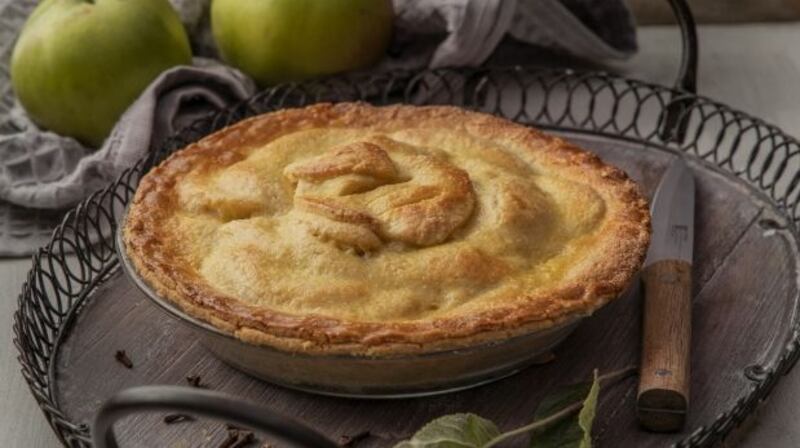
IRISH FARMHOUSE APPLE PIE
Serves six
Ingredients
For the apple filling:
4 or 5 Bramley cooking apples, peeled, cored and sliced
60g caster sugar
6 whole cloves
1 egg yolk, to glaze
125ml freshly whipped cream, to serve
For the pastry:
300g plain flour, sieved
150g chilled butter, diced small (plus extra for greasing)
60g caster sugar
1 egg or 2 tbsp cold water
Method
1. Preheat oven to 180 degrees Celsius, or equivalent and place a baking sheet inside to heat up. Lightly grease a pie dish with a little butter.
2. To make the pastry by hand, place the flour into a mixing bowl. Rub in the butter until the mixture resembles breadcrumbs. Mix in the sugar. Use a knife to work in the egg (or cold water), then bring together to form a dough (add a drop of water if required). Wrap the pastry up and refrigerate it for 20 minutes. (To make pastry in a food processor, blitz the flour, butter and sugar to fine breadcrumbs, then work in the egg to form a dough).
3. Divide the pastry into two balls of dough. On a lightly floured work surface roll out one piece of pastry into a circle and use it to line the buttered pie dish.
4. Fill the pie with half the sliced apples, dredge with half the sugar, then scatter with cloves. Repeat with the remaining apples and sugar.
5. Brush egg yolk over the rim of the pastry, before rolling out the second ball of dough into a circle and placing it over the apple filling. Use a sharp knife to trim off any overhanging pastry around the edge of the dish. Imprint the outer edge of the dish with your thumb (or crimp using the tines of a fork).
6. Use up any extra pastry by rolling it out and cutting out leaves or other shapes to decorate the pie. Glaze the entire surface of the pastry with egg yolk (which gives a lovely golden colour). Dredge with a little extra sugar. Use the tip of the knife to slash a pair of 2cm cuts in the pastry to enable the steam to escape; this is important to avoid the pastry rising above the apples and creating a gap beneath the lid.
7. Place on the middle shelf of the preheated oven and bake for 35-40 minutes (reduce the oven temperature once the pie is golden in colour).
8. Serve hot with whipped cream.
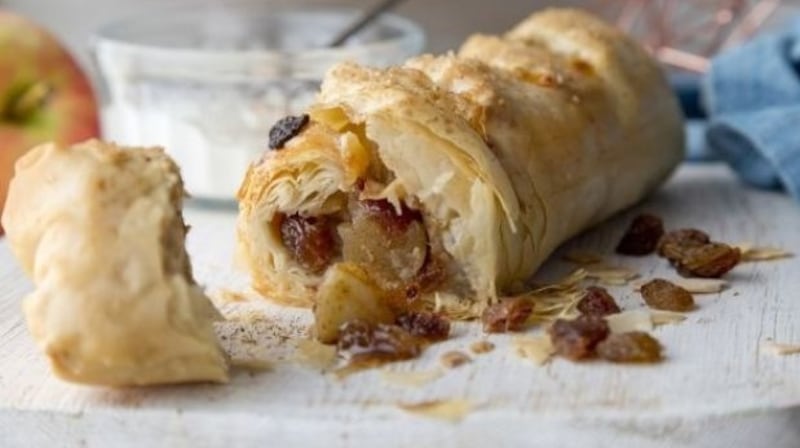
APPLE STRUDEL
Serves four
Ingredients
6-7 sheets filo pastry (approx 270g)
60g melted butter
For the filling:
4-5 large cooking apples, peeled, cored, cut into large dice
50g demerara sugar and extra for the top
Finely grated zest and juice of ½ lemon
1 tsp ground cinnamon
25g sultanas
50g flaked almonds
3-4 tbsp white breadcrumbs
150ml whipped cream, to serve
Method
1. Pre-heat the oven to 190 degrees Celsius, fan. Once the oven is hot, use a baking tray to lightly toast the almonds for six minutes or until golden, then crispen the breadcrumbs (approx 10 mins).
2. Place the apples, sugar, lemon juice and zest (and a splash of water if required) in a medium heavy-based saucepan. Cook on a low to medium heat for 5-8 minutes until starting to soften, add the cinnamon and sultanas. Remove from the heat and set aside to cool.
3. To assemble the strudel, place a rectangular sheet of filo pastry on a clean work surface, and working quickly so the pastry doesn’t dry out, brush with melted butter then continue layering and basting each sheet (reserve one unbasted).
4. Leaving a border at either short end, sprinkle a wide strip of toasted almonds down the middle, lay the reserved filo sheet on top and baste again. Sprinkle the breadcrumbs down the middle, then spoon the apple filling over the breadcrumbs forming a long mound.
5. Tuck the pastry ends inwards and fold the sides inwards to form a long parcel, basting with extra butter. Lift the parcel onto a baking tray. Use a knife to cut 3-4 diagonal slices into the top of the pastry to allow steam to escape. Brush the top with melted butter, and sprinkle with sugar.
6. Bake for 15 minutes to allow the pastry to colour nicely, then reduce the oven to 180 degrees Celsius fan, for 30-40, minutes until the pastry is golden.
7. Serve hot and crisp, in slices with whipped cream, custard or ice cream.
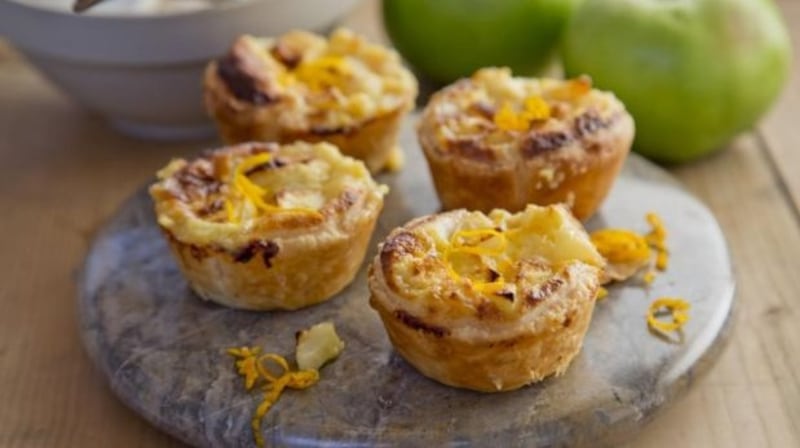
APPLE AND CUSTARD TARTS
Makes six
Ingredients
250-300g puff pastry sheet
2 egg yolks
75g caster sugar
1 level tbsp plain flour
120ml milk
1 tsp vanilla extract
Zest of 1 orange
1 cooking apple
Method
1. Preheat an oven to 220 degrees Celsius fan/gas 9. Lightly grease a six-hole muffin tray. Roll out the puff pastry to a thickness of two millimetres and stamp out six circles of pastry (each 10cm wide).
2. Gently press the pastry circles into the hollows, to the top edge of each (so they can hold all the liquid), then refrigerate them.
3. In a mixing bowl, use a wooden spoon to beat the egg yolks with the sugar until smooth and pale, then stir in the flour.
4. In a small saucepan, heat the milk with the vanilla and orange zest until just before it starts to boil, then remove it from the heat. Gradually pour the hot milk into the egg mix, whisking all the time with a hand whisk, while not creating too much foam.
5. Just before baking, peel and core the apple and cut into dice-sized cubes. Place three to four cubes of apple in each pastry hollow.
6. Fill with custard to the top. Cook for 20-25 minutes, until puffed up, set in the middle and slightly browned on top. Serve warm with ice-cream or freshly whipped cream.
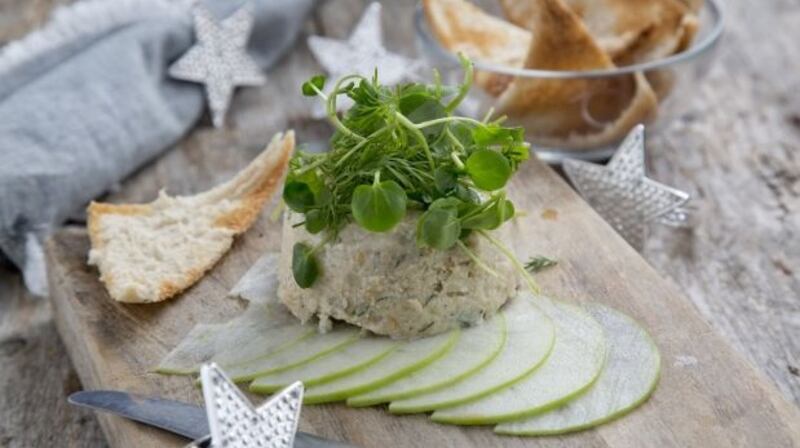
LIGHTLY SMOKED MACKEREL AND APPLE MOUSSE WITH MELBA TOAST
Serves six
Ingredients
6 slices white bread
1 sheet leaf gelatine
100ml water
3 Granny Smith apples, or similar (reserve 2 for garnish)
50g butter
3 fillets smoked mackerel (150g)
150ml cream
1 tbsp horseradish sauce
2 tbsp lemon juice (more to dip apple slices )
Pinch cayenne pepper
20g fresh dill
2 egg whites
1 tbsp sunflower oil
Handful baby watercress
Salt and pepper
Method
1. For Melba toast, toast the bread in a toaster, remove and cut off the crusts then slice through the side edge to make two thin slices. Grill, untoasted side up, until golden, then cut in half diagonally.
2. Peel, core and cube one of the apples and cook until slightly softened in the butter. Set aside to cool. Soak the leaf gelatine in cold water for a few minutes to soften. Squeeze excess water from the sheet before adding it to 100ml just boiled water, and allow to cool.
3. Remove the skin and blitz the mackerel fillets and cooked apple together. Add the cream, horseradish sauce, 1-2 tablespoons of lemon juice (to taste), pinch of cayenne, fresh dill and cooled gelatine. Blitz until combined, taste, then season with lots of black pepper.
4. Whisk two egg whites to soft peaks, gently fold in to fish mixture.
5. Lightly oil six ramekins or moulds with an unscented oil and pour mackerel mousse into each ramekin. Fill to the top. Allow to set for four hours, or overnight, in the fridge.
6. Cut the apples for the garnish into wafer thin discs. Dip the slices in lemon juice and press between two sheets of clingfilm so they do not discolour.
7. To serve, release mackerel mousses from moulds (briefly dip each ramekin base in a bowl of boiling water) and turn out. Garnish with baby watercress and serve chilled with the Melba toast.
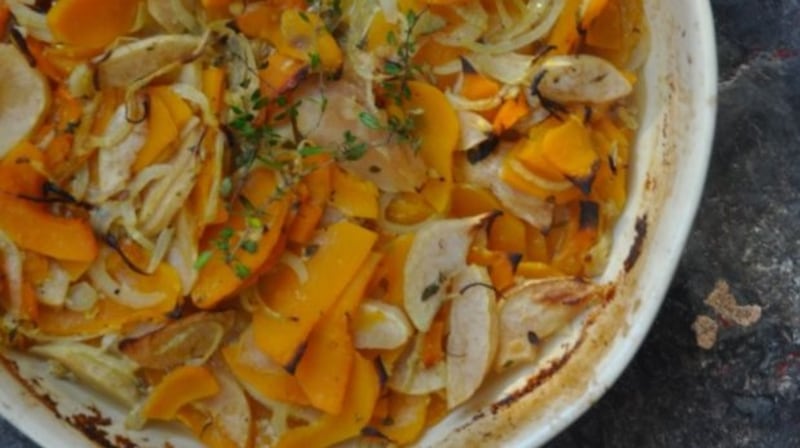
BUTTERNUT SQUASH, APPLE AND THYME GRATIN
Serves six
Ingredients
1 butternut squash
1 large onion
1 clove garlic, peeled and crushed
2 eating apples
100ml cream
250ml stock (chicken or vegetable)
Salt and black pepper
4 sprigs fresh thyme, leaves picked
Method
1. Preheat an oven to 220 degrees Celsius, or equivalent.
2. Mix the garlic with the milk and stock.
3. Peel the squash then cut in half and scoop out the seeds, slice thinly. Use a mandolin or food processor if you have one. Halve and slice the onions thinly too. Place in a large mixing bowl. Peel and thinly slice the apples. Add the apple to the squash. Season with salt and pepper and mix everything together gently.
4. Place half the slices into a large buttered oven-proof dish. Pour over half the stock mix. Scatter with half the thyme. Top with the remaining slices and pour over the stock.
5. Cover the dish with foil and bake for 40 minutes. Remove the foil and bake for a further 15 to 20 minutes, scattering over the remaining thyme for the final five minutes. Leave to rest for five minutes before serving.









